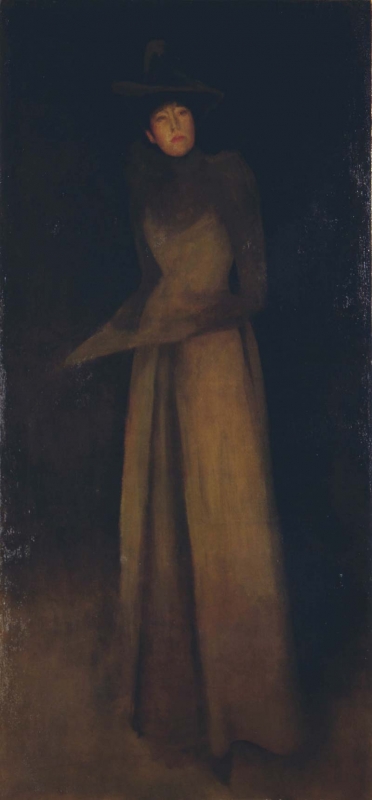Home > Catalogue > Browse > Harmony in Brown: The Felt Hat << >>
Titles
Whistler's own title is not known. Only one title has been recorded:
- 'Harmony in Brown: The Felt Hat' (1936, Glasgow University). 1
- 'Harmony in Brown: The Felt Hat' (1980, YMSM). 2
Description
A full-length portrait of a woman, in vertical format. She stands turned to the left, with her face tilted, looking up to right. She holds a pair of gloves in her hands. The gloves look rather like a fan or catalogue, but Whistler described her as holding 'a pair of gloves drawn out in the two hands' in a related lithograph, Gants de suède c035. 3 She wears a close-fitting pale brown dress with a deep pleat running the full-length of the skirt front. The narrow sleeves are dark brown, as is a scarf or tippet around her neck, and the sharply tilted felt hat. The floor is a light brownish ochre, darkening to very dark brown in the background.
Sitter
Ethel Whibley (1861-1920), née Birnie Philip, was one of the sisters of Whistler's wife. She was referred to by Whistler as 'Bunnie'. This is one of a number of portraits of her, including the lithograph Gants de suède c035, showing Ethel in a similar costume and pose to this painting.
Whistler, Women and Fashion noted: 'The somber, rather masculine dress and hat strike an important chord regarding women's dress of the 1890s – the increased fashion for simplicity,' and commented on Ethel's taste for feathered hats: 'Ethel Philip appears ... in a range of plumed hats, which looked well on her strong oval face with its clean-cut profile.' 4
Comments
Muther described Whistler in his studio, in an interesting – if romanticized – account, dating probably from the early 1890s:
'Whistler seemed like a hermit in his secluded house, like the monarch of a far kingdom, peopled only with his own thoughts – a realm where he reigned in the midst of mysterious landscapes and grave and quiet men and women, who have stood near him in mind and spirit, and to whom his brush gave new life. The thoughtful eyes of women gazed upon you; fair hair, black and grey furs, pale, fading flowers, and grey felt hats with black feathers stood out from dusty canvases placed carelessly to one side, sometimes taking definite form, sometimes melting intangibly and indistinctly, as if seen through silky veils. The air which enveloped them was at the same time bright and dark; the atmosphere of this silent room, in which the artist saw his models, had a subdued and shrouded daylight, and old light, as it were, which had become harmonious like a faded Gobelin.' 5
The 1995 Tate exhibition catalogue warned:
'We must be very careful about attributing to an unfinished painting qualities Whistler never intended it to have. Nevertheless, the way in which the elongated figure seems to emerge, wraith-like, from the shadowy background, the absence of details and textures, and above all the tendency to flatten form against a spatially ambiguous background: all put one in mind of the Symbolist art nouveau paintings of Gustav Klimt. It is therefore worth noting that on 13 December 1897 Klimt wrote to Whistler inviting him to accept honorary membership in the Society of Austrian Artists Secession.' 6
Notes:
1: James McNeill Whistler, University of Glasgow, Glasgow, 1936.
2: YMSM 1980 [more] (cat. no. 395).
3: Whistler to T. R. Way, [11 December 1893], GUW #03357.
4: MacDonald 2003 [more], pp. 41, 193.
5: Muther 1895 [more], chapter 38, pp. 3-4. The German edition reads, ''… ernster, stiller Menschen, die seinem Herzen und seinem Geiste nahe waren und die sein Pinsel zu neuem Leben erweckte. Sinnende Frauenaugen blicken dich an, blonde Haare, schwarzgraue Pelze, bleiche, welkende Blumen und graue Filzhute mit schwarzer Feder losen von verstaubten, achtlos bei Seite gestellten Leinwandflachen sich los, bald feste Form annehmend, bald wieder verschwimmend, ungreif- bar, undeutlich wie durch grauseidenen Schleier gesehen. Die Luft, die sie umfliesst, ist zugleich dunkel und hell: die Atmosphare dieses schweigsamen Zimmers, in dem der Maler seine Modelle sieht, ein abgetontes, umschleiertes Tageslicht, gleichsam ein altes Licht, das harmonisch geworden wie ein gebleichter Gobelin.' Muther 1894 [more], at pp. 525-26.
6: Dorment, Richard, and Margaret F. MacDonald, James McNeill Whistler, Tate Gallery, London, Musée d’Orsay, Paris, and National Gallery of Art, Washington, DC, 1994-1995 (cat. no. 198).
Last updated: 22nd October 2020 by Margaret







